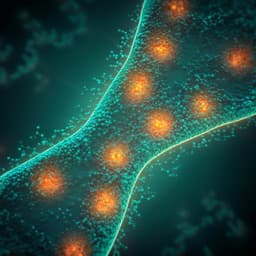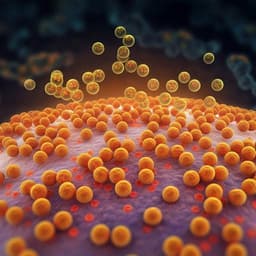
Environmental Studies and Forestry
Cracking the code of seasonal seawater biofouling: enhanced biofouling control with quorum sensing inhibitor-functionalized membranes
C. Chen, Y. Yang, et al.
This groundbreaking research by Chao Chen and colleagues examines the seasonal dynamics of microbial communities' impact on membrane biofouling in seawater reverse osmosis systems. The study showcases innovative quorum sensing inhibitor-modified membranes that effectively suppress detrimental bacteria, offering promising solutions to enhance desalination efficacy.
Playback language: English
Introduction
Seawater reverse osmosis (SWRO) desalination is crucial for addressing freshwater scarcity, accounting for a significant portion of global installed desalination capacity. However, membrane biofouling, caused by bacterial attachment and biofilm formation, severely impacts SWRO system efficiency and longevity. Biofilms, composed of bacteria and their secreted extracellular polymeric substances (EPS), significantly reduce membrane flux, leading to substantial operational challenges and economic losses. Traditional chlorine-based pretreatment methods can damage RO membranes, while biocides can lead to resistant bacterial strains, with even minimal surviving bacteria capable of regenerating mature biofilms. Therefore, a sustainable and effective alternative to existing biofouling control methods is urgently needed.
Quorum sensing (QS) is a bacterial cell-to-cell communication mechanism regulating various behaviors, including biofilm formation. QS inhibitors (QSIs) offer an eco-friendly approach by disrupting these communication pathways, thereby reducing biofilm formation and mitigating biofouling. Previous studies have demonstrated the efficacy of QSIs like acylase (AC) and methyl anthranilate (MA) in reducing biofilm formation by *P. aeruginosa*. However, the direct dispersion of inhibitors can lead to reduced efficacy and potential secondary pollution. Immobilizing QSIs onto the membrane surface is a promising strategy to overcome these limitations, offering sustained QSI release and preventing environmental contamination.
While laboratory studies have examined biofouling using model bacteria, the diverse microbial communities in seawater present a more complex scenario. Seasonal variations in microbial communities and EPS composition have been observed, influencing biofouling behavior. This research aims to address the lack of understanding of QSIs' roles in regulating diverse seawater microbial communities and their impact on SWRO membrane biofouling. Specifically, the study investigates the seasonal changes in bacterial communities in SWRO, explores the correlation between these communities and biofouling, and examines the efficacy of AC- and MA-modified membranes in controlling seasonal biofouling.
Literature Review
Numerous studies have focused on membrane biofouling in SWRO desalination, highlighting its detrimental effects on membrane performance and overall system efficiency. Research has extensively explored the role of extracellular polymeric substances (EPS) in biofouling, demonstrating their contribution to biofilm adhesion and stability. The diversity of microbial communities in seawater has also been recognized as a crucial factor influencing biofouling patterns. Studies have shown seasonal variations in microbial composition and the relationship between specific bacterial genera and biofilm formation. The use of chemical disinfectants like chlorine has limitations due to membrane damage and the development of chlorine-resistant bacteria. Alternative approaches, including the use of biocides and advanced membrane materials, have shown some success, but often have limitations in terms of effectiveness and environmental impact. The use of quorum sensing inhibitors (QSIs) to control biofouling is a relatively novel approach that has shown promising results, offering a potentially more sustainable and effective alternative to traditional methods. Several studies have investigated the use of different QSIs to mitigate biofilm formation and reduce membrane fouling. However, further research is needed to fully understand the mechanisms of action of QSIs in diverse microbial communities and to optimize their application in real-world SWRO systems.
Methodology
This study employed a multi-faceted approach to investigate seasonal seawater biofouling and evaluate the effectiveness of QSI-modified membranes. The methodology included:
**1. Membrane Modification:** Anti-biofouling SWRO membranes were fabricated by incorporating QSIs (AC and MA) onto a polyamide membrane. This involved a two-step process: first, a polydopamine (PDA) layer was coated onto the membrane, followed by the covalent attachment of QSIs (AC and MA) via a Schiff base reaction with glutaraldehyde (GA) as a crosslinking agent. The modified membranes (AC_m and MA_m) were characterized using various techniques (e.g., FTIR, XPS, contact angle measurements) to confirm the successful incorporation of QSIs.
**2. Seawater Sampling and Microbial Consortia Enrichment:** Natural seawater (NSW) samples were collected from Bohai Bay over four seasons (winter, spring, summer, and fall). Microbial consortia were extracted and enriched from the NSW samples to represent the natural microbial community present in the seawater.
**3. Dynamic Biofouling Experiments:** Dynamic crossflow SWRO experiments were conducted using the pristine and QSI-modified membranes. The experiments were performed with the enriched microbial consortia under four different seasonal conditions. Membrane flux and salt rejection were continuously monitored to assess biofouling development. Operational parameters (pressure, temperature, and crossflow velocity) were kept consistent across all experiments.
**4. Biofilm and EPS Analysis:** After the biofouling experiments, the fouled membranes were analyzed to determine the amount of EPS (proteins, polysaccharides, and eDNA) accumulated on the membrane surface. The total organic carbon (TOC), microbial biomass, and biofilm thickness were also measured using appropriate techniques. Confocal laser scanning microscopy (CLSM) was used to visualize and quantify biofilm structure and microbial activity (live/dead cell ratios).
**5. Microbial Community Analysis:** High-throughput 16S rRNA gene sequencing was performed to characterize the microbial community composition in both the seawater and the biofilm formed on the membranes. The data was analyzed to identify dominant phyla, classes, and genera, and their seasonal variations were analyzed. Phylogenetic molecular ecological networks (PMENs) were constructed to reveal the interactions between bacterial taxa and to identify keystone species contributing to biofouling.
**6. Metabolic Analysis:** Metabolic analysis was conducted using functional annotation of 16S rRNA gene sequences, focusing on pathways related to carbohydrate and amino acid metabolism, which are crucial in EPS production. The relative abundance of genes involved in these pathways was compared between the control and QSI-modified membranes to understand the impact of QSIs on bacterial metabolism.
Key Findings
This study revealed several key findings regarding seasonal biofouling and the effectiveness of QSI-functionalized membranes:
**Seasonal Variation in Microbial Communities:** The microbial diversity in seawater varied significantly across seasons, with higher diversity observed during warmer months. Proteobacteria dominated the membrane biofilms in all seasons, with Alpha- and Gammaproteobacteria being the most abundant classes. However, the relative abundance of other bacterial classes varied seasonally. Cyanobacteria showed a higher relative abundance during the winter compared to other seasons.
**Keystone Species Identification:** Phylogenetic molecular ecological networks (PMENs) identified *Rhodobacteraceae*, *Vibrio*, and *Arcobacter* as keystone species positively correlated with EPS production and biofilm formation. These species were found in higher abundance on the pristine membranes during spring, summer and fall, coinciding with increased EPS accumulation and severe biofouling.
**Impact of QSI-Modified Membranes:** The AC_m and MA_m membranes significantly reduced membrane fouling compared to the pristine membrane. The reduction in flux decline was more pronounced in the summer, when biofouling was most severe on pristine membranes. The QSI-modified membranes significantly decreased the total amount of EPS (polysaccharides, proteins, and eDNA) accumulated on the membrane surface, reducing the biofilm thickness. Furthermore, the QSI-modified membranes altered the microbial community structure, significantly decreasing the abundance of several key fouling-related bacteria, including *Rhodobacteraceae* and *Arcobacter*. Notably, the QSI membranes exhibited similar live/dead cell ratios compared to the pristine membrane, suggesting that the observed antifouling effect was not due to bactericidal activity but rather due to the inhibition of biofilm development.
**Metabolic Effects of QSIs:** Metabolic analysis indicated that the AC and MA modified membranes significantly decreased the abundance of genes involved in carbohydrate and amino acid metabolism pathways (map00260 and map00520) associated with EPS production. The reduction in the abundance of genes involved in the synthesis of crucial metabolites like glucose, galactose, and UDP-N-acetylglucosamine, suggests that the QSIs suppressed EPS biosynthesis, contributing to the observed reduction in biofouling.
Discussion
The findings of this study provide valuable insights into the complex interplay between seasonal microbial community dynamics and SWRO membrane biofouling. The significant seasonal variations in microbial diversity and the identification of keystone species highlight the importance of considering seasonal factors in the design and implementation of effective anti-biofouling strategies. The successful application of QSI-functionalized membranes in mitigating membrane fouling demonstrates the potential of this approach for improving SWRO performance. The observation that QSI-modified membranes reduced biofilm formation without exhibiting significant bactericidal activity suggests a mechanism primarily based on the disruption of bacterial communication and coordination, rather than direct bacterial killing. The alteration of microbial community structure and the impact on key metabolic pathways further supports this mechanism. These findings have significant implications for developing sustainable and effective biofouling control strategies for SWRO systems. Future research could focus on investigating the long-term stability of QSI-functionalized membranes, exploring other QSIs with improved efficacy, and evaluating the economic feasibility and scalability of this technology for real-world applications.
Conclusion
This research systematically investigated the seasonal dynamics of SWRO membrane biofouling and demonstrated the efficacy of quorum sensing inhibitor (QSI)-functionalized membranes in mitigating this issue. Seasonal variations significantly impacted microbial community composition, with Proteobacteria, particularly Alpha- and Gammaproteobacteria, being dominant in biofilms. Keystone species like *Rhodobacteraceae*, *Vibrio*, and *Arcobacter* were identified, showing a strong correlation with EPS and biofilm formation. AC and MA-modified membranes effectively suppressed these bacteria, reducing EPS and alleviating flux decline. This research provides valuable insights into seasonal biofouling and the promise of QS inhibition for anti-biofouling strategies in SWRO systems. Future work should explore optimizing QSI selection and membrane modification techniques to enhance long-term stability and scalability for real-world applications.
Limitations
While this study provides valuable insights, some limitations need to be acknowledged. The study was conducted using a laboratory-scale experimental setup, which may not fully replicate the complexities of real-world SWRO operations. The specific microbial communities and environmental conditions in Bohai Bay may not be representative of all seawater environments. Long-term performance and stability of the QSI-modified membranes under various operational conditions remain to be fully evaluated. Further research is needed to assess the potential for the development of QSI-resistant bacterial strains over time.
Related Publications
Explore these studies to deepen your understanding of the subject.







